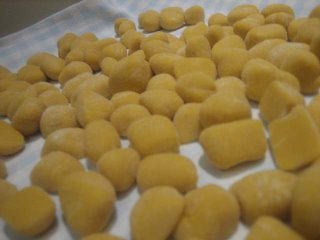Gnocchi is one of the most loved Italian dishes. Very often is mispronuced. First because the "gn" sound doesn't exist in many languages, then the "chi" which is guttural (=ki), then the double c. Italians do pronouce doubles. Here is a useful
Guide to pronunciation.
The most common being potato gnocchi. Italians would fight over this simple recipe.
I will list all the points that I have heard during years of internet surfing.
1. Everybody agrees that the most important thing is the quality of the potatoes. Floury. If the potato is waxy the gnocchi will come out pourly.
2. Eggs, no eggs. If your potatoes are good you don't need eggs. But if you are unsure of the quality, better to add an egg to be safe. For recipe with added moist vegetables the egg is going to be in there (you could add spinach, nettles, radicchio, etc.)
3. No whipping tools of any kind that will make the potatoes gluey. Even a manual vegetable mill is not the most ideal. Better using a proper italian potato ricer. And to rice the potatoes when they are hot.
4. The potatoes need to be cooked unpeeled, starting from cold salty water. Better even to steam them. Do not overcook. Peel and rice immediately.
5. When to knead the dough. It is ideal to drop the riced potatoes on a wooden table board, so that it will absorb humidity in excess. Some people like to add flour and knead when the potatoes are still warm. Other people like to wait until they are cold, because they think it would otherwise take too much flour.
6. while you are cutting out the gnocchi keep the board dusted with flour and using a pastry scaper transfer on a flour dusted kitchen towel over a tray. Gnocchi don't keep well. They need to be cooked within a couple hours they have been made or they will get soggy. Every one in a while, go and shake the tray to make sure they are not sticking. In any case gnocchi can be frozen successfully on a baking tray.
Gnocchi are cooked in plenty of simmering salted water. When they come to surface they are done. Do not use a colander, rather a perforated spoon to collected them.
Most common and loved way of dressing is butter and sage. Butter brought to noisette stage with fresh sage. Parmigiano at the table.
Being my mom from Bergamo I often go with my grandfather recipe which asks for a lot of chopped parsley in the dough. In Bergamo people like to add some pancetta to the butter.
Gnocchi are very good also simply dressed with tomato sauce.
Besides the common potato gnocchi there are many other, often local, variations.
Ricotta gnocchi. In general very soft. Most popular are ricotta and chopped spinach. In Sardinia (where saffron is usually added), Toscana, Emilia and in some areas in the North these ricotta/spinach gnocchi are called "malfatti", they are usually of pretty big size. In Piemonte, it is used a ricotta called seraiss and their medium size spinach ricotta gnocchi are called rabaton. In Toscana they are called gnudi, which meands naked, like a naked raviolo.
In Bologna ricotta gnocchi are tiny and are made just with ricotta and flour, rolled on the table. In Piacenza, very tiny gnocchi, called chicche della nonna, are made with potato, ricotta, egg and flour...
Squash gnocchi. Again, different kinds, you could go for a potato/squash/egg/flour gnocco or prepare them in the tradition of Friuli. The squash used is usually not watery, it is cut, wrapped in foil and baked. Then to the pured squash, eggs and flour are added. It is dropped in simmering water and dressed with melted butter and chips of grated smoked ricotta friulana.
I remember also this recipe from Fausto Fraccalini
web site on cucina mantovana. Fausto, many years ago, used to write on the Cucina Italiana Forum. According to his recipe, the squash is cooked and pureed. To the pure more water is added and when it comes to a boil enogh flour to form a ball is thrown in the pot. Basically it is about making a panade with the squash pure'.
For all the soft kind of gnocchi I really reccomand a pasty bag, it will facilitate the task a lot.
Chestnut gnocchi in the Appennino area, in between Liguria, Emilia and Toscana.
Semolino gnocchi. Roman style or in Trentino more german style, dropped and cooked in simmering stock.
Flour gnocchi. Same technic I was discussing for the squash gnocchi. Basically a panade. In this category could be comprise the "parisienne gnocchi", which, in fact, are a staple in the North.
Polenta gnocchi. Often left over polenta is used.
Bread gnocchi. In this category to me enter the Trentino gnocchi, Canederli, Knoedel. Or the gnocchi made with breadcrumbs and flour, for example Pisarei e Faso' from Piacenza.
More to come as soon as I recall more kinds.






